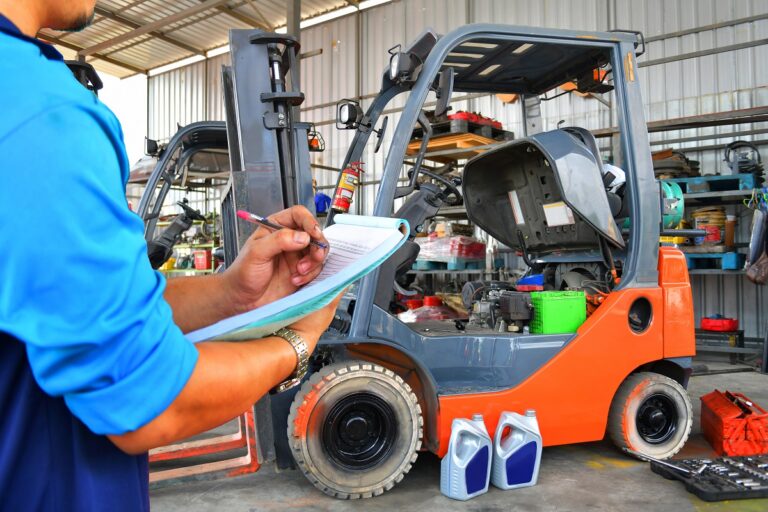A forklift service can seem like a hassle since you must plan a break when the truck can’t be employed and pay a professional to conduct the job. Still, it’s necessary to maintain your forklift in excellent operating condition. Proper forklift repair lowers the likelihood that your forklift may break down and need expensive essential maintenance. What does a forklift service involve? The comprehensive guide to servicing is provided here.
Why Is Forklift Servicing Important?
Regular repairs are performed as a component of forklift service. Keep your forklift functioning as smoothly and effectively as possible. A competent service must fine-tune its mechanics. Moreover, it must anticipate potential issues and proactively stop its forklift truck from malfunctioning, such as changing worn-out components. These two actions are crucial for safety and financial reasons alike. First and foremost, you want to eliminate any potential for industrial accidents, which might harm and damage your employees’ health. Second, the price of unplanned downtime and possibly costly repairs is often higher than that of periodic, scheduled maintenance.
During Service, What Needs To Be Examined?
While forklift truck servicing may be complicated, its principle is relatively straightforward. An on-site service professional will inspect the forklift’s numerous components to ensure it operates as efficiently as possible. The following will be some of these:
- The braking and operating system of the forklift
- The forklift’s command mechanism its hydraulics, lift chains, forks, and mast
- The electric motor or engine of the forklift
- Body of forklift
- Any safety features
The professional must demonstrate how they are all being checked. Avoid the temptation to choose a very inexpensive service. Forklift service must do a complete inspection of the car’s components and operation to see if everything is in perfect working order and if nothing needs fixing. For standard and massive forklifts, this must take at least an hour; also, for walkie forklifts, it ought to only take thirty minutes. If your job is completed in less time, it’s possible that not all aspects are being inspected as thoroughly as they should be.
What Is Fixed During A Service?
It sometimes needs to be assessed how effectively the forklift operates. Mostly, the technician will find a problem that needs simple forklift repair. This is very typical and helps to avoid an expensive failure later on. This is to list the components that often need to be repaired during service.
Moving Forklift Parts
Maintaining vital areas on your machine greased at all times is critical. Moving components generate friction without lubrication, which leads to wear and tear. Thus, lubricating is an essential component of your forklift service regimen as it minimizes friction, enhances the operation of your forklift parts, lengthens the lifespan of machine systems, and lowers the likelihood of a breakdown, which may have a negative influence on production. Consider seeing your expert generously lubricate the relevant components.
Tyres
If the tyres are worn out or broken, they will have more resistance, resulting in more fuel consumption. Hence, maintaining proper tyre conditions will result in lower operating expenses.
Worn Components
If the device has worn-out components that need to be changed, it is one of the main things a technician will look for during service. Preventative maintenance on worn-out parts helps you save money in two key ways. First, it often results in faster service, reducing fuel expenses due to your forklift’s improved efficiency. Second, repairing the defective component before it failed would have averted harm to neighbouring parts that occur when parts break while in operation. You may also save money by replacing worn-out components since doing so lowers the probability of unanticipated downtime.
Filters And Lines
Forklift trucks often work in environments covered with dust, dirt, or debris. Filters within a forklift keep the hydraulic fluid, oil, and air clean. Sediment may accumulate on these filters and at other locations within the forklift’s body, with disastrous results for the vehicle’s internal workings. The buildup may sometimes cause errors and premature component failure, which are expensive. So, the service specialist must inspect the forklift’s lines and filters for buildupbuildup and clean them as required.
What Must Safety Precautions Be Taken During Servicing?
Be sure that your forklift truck is only serviced and maintained by professionals that are entirely certified. If anything goes wrong due to poor service, it will probably be expensive to correct, require unscheduled downtime while the equipment is repaired, and might endanger the health of your employees. These safety precautions must be observed during a forklift servicing, even though your operator must be knowledgeable about all proper safety measures.
Wear PPE as Needed
Always wear proper gear. Additional protection must be worn when grinding, working near battery-charging equipment, touching lead-acid batteries, or refilling LPG fuel tanks.
Check Records
Specialists must examine the driver’s checklist before repairing it. Before operating or running the forklift, specialists must check for faults.
Remove Batteries
Disconnect batteries before working.
Clean Your Workstation
Clean oil and gasoline spills quickly. Servicing must be done in a well-lit, clutter-free location. Clean and inspect tools before use.
Service LPG Forklifts Correctly
LPG forklift servicing requires closing the tank fuel valve. Once the engine stops, detach the tank from the hose and start the servicing.
Support and Block
Before removing the forklift’s wheels or doing comparable maintenance, block it. While lifting the forklift canopy, support it or remove it.
Avoid Battery Terminals
Generally avoid tools, chains, and hoists. If possible, insulate battery tops.
Forklift service is vital for maintaining lift trucks in good working order and minimizing downtime, but maintaining large gear may be risky. The easiest method to avoid significant injuries is to adhere to the best standards for service safety matters.


Comments are closed.